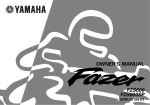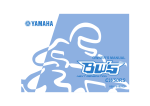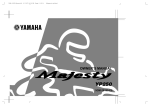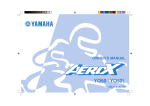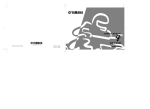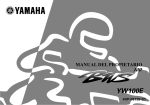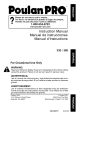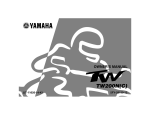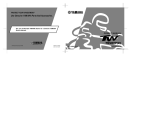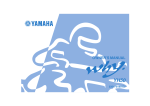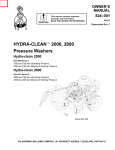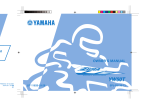Download Yamaha BWS YW100E Owner`s manual
Transcript
OWNER’S MANUAL YW100E 4VP-F8199-E1 INTRODUCTION EAU00001 Welcome to the Yamaha world of motorcycling! As the owner of a BW’S100, you are benefiting from Yamaha’s vast experience in and newest technology for the design and the manufacture of high-quality products, which have earned Yamaha a reputation for dependability. Please take the time to read this manual thoroughly, so as to enjoy all your BW’S100’s advantages. The owner’s manual does not only instruct you in how to operate, inspect and maintain your scooter, but also in how to safeguard yourself and others from trouble and injury. In addition, the many tips given in this manual will help to keep your scooter in the best possible condition. If you have any further questions, do not hesitate to contact your Yamaha dealer. The Yamaha team wishes you many safe and pleasant rides. So, remember to put safety first! 4VP-F8199-E1.pm65 1 2/4/2004, 4:21 PM IMPORTANT MANUAL INFORMATION EAU00005 Particularly important information is distinguished in this manual by the following notations: Q The Safety Alert Symbol means ATTENTION! BECOME ALERT! YOUR SAFETY IS INVOLVED! w Failure to follow WARNING instructions could result in severe injury or death to the scooter operator, a bystander or a person inspecting or repairing the scooter. cC A CAUTION indicates special precautions that must be taken to avoid damage to the scooter. NOTE: A NOTE provides key information to make procedures easier or clearer. NOTE: 9 This manual should be considered a permanent part of this scooter and should remain with it even if the scooter is subsequently sold. 9 Yamaha continually seeks advancements in product design and quality. Therefore, while this manual contains the most current product information available at the time of printing, there may be minor discrepancies between your scooter and this manual. If there is any question concerning this manual, please consult your Yamaha dealer. 4VP-F8199-E1.pm65 2 2/4/2004, 4:21 PM IMPORTANT MANUAL INFORMATION EW000002 w PLEASE READ THIS MANUAL CAREFULLY AND COMPLETELY BEFORE OPERATING THIS SCOOTER. 4VP-F8199-E1.pm65 3 2/4/2004, 4:21 PM EAU00008 YW100E OWNER’S MANUAL © 1999 by Yamaha Motor Taiwan Co., Ltd. 1st Edition, March 1999 All rights reserved. Any reprinting or unauthorized use without the written permission of Yamaha Motor Taiwan Co., Ltd. is expressly prohibited. Printed in Taiwan 4VP-F8199-E1.pm65 4 2/4/2004, 4:21 PM EAU00009 TABLE OF CONTENTS 1 GIVE SAFETY THE RIGHT OF WAY ................. 1-1 Front trunk .................................................... 3-8 Luggage hook ...............................................3-8 Sidestand ......................................................3-8 Sidestand switch operation check .............. 3-9 FURTHER SAFE RIDING POINTS FOR THIS MODEL .............................................................. 1-2 2 3 DESCRIPTION ................................................... 2-1 Left view ........................................................ 2-1 Right view ..................................................... 2-2 Controls / Instruments ................................. 2-3 INSTRUMENT AND CONTROL FUNCTIONS ...................................................... 3-1 Main switch / Steering lock ......................... 3-1 Indicator lights .............................................. 3-2 Speedometer ................................................ 3-2 Fuel gauge .................................................... 3-2 Handlebar switches ...................................... 3-3 Front brake lever .......................................... 3-4 Rear brake lever ........................................... 3-4 Fuel and oil tanks ......................................... 3-4 Fuel ................................................................ 3-5 Fuel tank breather hose ............................... 3-5 Two-storoke engine oil ................................ 3-6 Kick starter .................................................... 3-6 Seat ............................................................... 3-6 Helmet holder ............................................... 3-7 Trunk ............................................................. 3-7 Rear carrier ................................................... 3-8 4VP-F8199-E1.pm65 5 4 PRE-OPERATION CHECKS ...............................4-1 Pre-operation check list ...............................4-1 5 OPERATION AND IMPORTANT RIDING POINTS .............................................................. 5-1 Starting up a cold engine ............................ 5-1 Starting off .................................................... 5-2 Acceleration ..................................................5-2 Braking .......................................................... 5-2 Engine break-in ............................................ 5-2 Parking .......................................................... 5-3 6 PERIODIC MAINTENANCE AND MINOR REPAIR .............................................................. 6-1 Took kit .......................................................... 6-1 Periodic maintenance and lubrication ........6-3 Cowling and panel removal and installation .................................................... 6-6 Cowling A .....................................................6-6 Panel B .......................................................... 6-7 Spark plug .....................................................6-7 2/4/2004, 4:21 PM TABLE OF CONTENTS Final gear oil replacement ........................... 6-9 Air filter cleaning .......................................... 6-9 Carburetor adjustment .............................. 6-11 Throttle cable free play adjustment .......... 6-11 Tires ............................................................. 6-12 Wheels ........................................................ 6-14 Front brake adjustment ............................. 6-14 Rear brake adjustment ............................... 6-14 Checking the front brake pads and brake shoes ................................................. 6-15 Inspecting the brake fluid level ................. 6-16 Brake fluid replacement ............................. 6-16 Cable inspection and lubrication .............. 6-16 Throttle cable and grip lubrication ........... 6-17 Autolube pump adjustment ...................... 6-17 Brake lever lubrication ............................... 6-17 Center and sidestand lubrication .............. 6-17 Front fork inspection .................................. 6-18 Wheel bearings .......................................... 6-18 Steering inspection .................................... 6-19 Battery ......................................................... 6-19 Fuse replacement ....................................... 6-20 Headlight bulb replacement ...................... 6-21 Turn signal and taillight bulb replacement ................................................ 6-21 License light bulb replacement ................. 6-22 4VP-F8199-E1.pm65 6 Troubleshooting .........................................6-23 Troubleshooting chart ............................... 6-24 7 SCOOTER CARE AND STORAGE ....................7-1 Care ............................................................... 7-1 Storage .......................................................... 7-4 8 SPECIFICATIONS .............................................. 8-1 9 CONSUMER INFORMATION ........................... 9-1 Identification numbers records ................... 9-1 Key identification number ........................... 9-1 Vehicle identification number ..................... 9-1 Engine serial number ...................................9-2 2/4/2004, 4:21 PM TABLE OF CONTENTS 4VP-F8199-E1.pm65 7 2/4/2004, 4:21 PM EAU00021 Q GIVE SAFETY THE RIGHT OF WAY Scooters are fascinating vehicles, which can give you an unsurpassed feeling of power and freedom. However, they also impose certain limits, which you must accept; even the best scooter does not ignore the laws of physics. Regular care and maintenance are essential for preserving your scooter’s value and operating condition. Moreover, what is true for the scooter is also true for the rider: good performance depends on being in good shape. Riding under the influence of medication, drugs and alcohol is, of course, out of the question. Scooter riders - more than car drivers - must always be at their mental and physical best. Under the influence of even small amounts of alcohol, there is a tendency to take dangerous risks. Protective clothing is as essential for the scooter rider as seat belts are for car drivers and passengers. Always wear a complete motorcycle suit (whether made of leather or tear-resistant synthetic materials with protectors), sturdy boots, motorcycle gloves and a properly fitting helmet. Optimum protective wear, however, should not encourage carelessness. Though full-coverage helmets and suits, in particular, create an illusion of total safety and protection, motorcyclists will always be vulnerable. Riders who lack critical self-control run the risk of going too fast and are apt to take chances. This is even more dangerous in wet weather. The good motorcyclist rides safely, predictably and defensively - avoiding all dangers, including those caused by others. Enjoy your ride! 1-1 4VP-F8199-E1.pm65 8 2/4/2004, 4:21 PM EAU02964 FURTHER SAFE RIDING POINTS FOR THIS MODEL 1. Left turn 1. 8 Be sure to signal clearly when making turns. 8 Braking can be extremely difficult on a wet road. Avoid hard braking, because the scooter could slide. Apply the brakes slowly when stopping on a wet surface. 8 Slow down as you approach a corner or turn. Once you have completed a turn, accelerate slowly. 8 Be careful when passing parked cars. A driver might not see you and open a door in your path. Right turn 8 Street car rails, iron plates on road construction sites, and man-hole covers become extremely slippery when wet. Slow down and cross them with caution. Keep the scooter upright. It could slide out from under you. 8 The brake lining could get wet when you wash the scooter. After washing the scooter, check the brakes before riding. 8 Always wear a helmet, gloves, trousers (tapered around the cuff and ankle so they do not flap), and a bright colored jacket. 8 Do not carry too much luggage on the scooter. An overloaded scooter is unstable. Use a strong cord to secure any luggage to the luggage rack. A loose load will affect the stability of the scooter and could divert your attention from the road. 1-2 4VP-F8199-E1.pm65 9 2/4/2004, 4:21 PM DESCRIPTION Left view 4 3 5 2 6 1 7 8 9 0 1. 2. 3. 4 5. Headlights Front turn signal Luggage hook Seat Rear carrier (page 6-20) (page 6-21) (page 3-8) (page 3-6) (page 3-8) 6. 7. 8. 9. 10. Rear turn signal Kick starter Air filter Centerstand Sidestand 2-1 4VP-F8199-E1.pm65 10 2/4/2004, 4:21 PM (page 6-21) (page 3-6) (page 6-9) (page 6-17) (page 3-8) DESCRIPTION Right view e r t y w q u 11. 12. 13. 14. 15. Rear wheel Rear turn signal Taillight Fuel tank Trunk (page 6-14) (page 6-21) (page 6-21) (page 3-5) (page 3-7) 16. Battery 17. Front wheel 2-2 4VP-F8199-E1.pm65 11 2/4/2004, 4:21 PM (page 6-19) (page 6-14) DESCRIPTION Controls/Instruments p s a 60 40 20 0 d f 80 100 120 140 0000001 i g o 18. 19. 20. 21. 22. h Rear brake lever Left handlebar switches Speedometer Turn indicator High beam indicator (page 3-4) (page 3-3) (page 3-2) (page 3-2) (page 3-2) 23. 24. 25. 26. Oil level indicator light Fuel gauge Front brake lever Right handlebar switches 2-3 4VP-F8199-E1.pm65 12 2/4/2004, 4:21 PM (page 3-2) (page 3-2) (page 3-4) (page 3-3) INSTRUMENT AND CONTROL FUNCTIONS EAU02954 * The oil level indicator light should come on. For details about the oil level indicator light, refer to “Oil level indicator light” on page 3-2. EAUT0042 EAU00029 Main switch/Steering lock The main switch controls the ignition and lighting systems. Its operation is described below. EAU00036 ON Electrical circuits are switched on. The engine can be started. The key cannot be removed in this position. EAU00038 LOCK The steering is locked in this position and all electrical circuits are switched off. The key can be removed in this position. To lock the steering, turn the handlebars all the way to the left. With the key at “OFF”, push it into the main switch and release it, turn it counterclockwise to “LOCK” and remove it. To unlock the steering, push the key into the main switch and turn it to “OFF”. EW000016 w Never turn the key to “OFF” or “LOCK” when the scooter is moving. The electrical circuits will be switched off which may result in loss of control or an accident. Be sure the motorcycle is stopped before turning the key to “OFF” or “LOCK”. OFF All electrical circuits are switched off. The key can be removed in this position. 3-1 4VP-F8199-E1.pm65 13 2/4/2004, 4:21 PM INSTRUMENT AND CONTROL FUNCTIONS immediately with Yamalube 2 or 2stroke engine oil (JASO FC grade or ISO EG-C, EG-D grade). When the tank is refilled, the indicator light should go off. 1 23 60 40 20 0 1. 2. 3. 80 1 60 NOTE: 100 120 140 0000001 Turn indicator light”5” High beam indicator light”&” Oil level indicator light”7” EAU00056 Indicator lights EAU00057 Turn indicator light “5” This indicator flashes when the turn switch is moved to the left or right. EAU00063 High beam indicator light “&” This indicator comes on when the headlight high beam is used. EC000000 cC Do not run the scooter until you know it has sufficient engine oil. EAU02958 Oil level indicator light “7” The light comes on when the key is in the “*” position or when there is little oil in the oil tank during operation. If the oil indicator light comes on during operation, refill the tank 1. 2. 14 140 0000001 Speedometer Fuel guage EAU00098 Speedometer The speedometer shows riding speed. This speedometer is equipped with an odometer. EAU02950 Fuel gauge The fuel gauge indicates the quantity of the remaining gasoline in the tank. The gauge needle moves from “F” (Full) to “E” (Empty) as the fuel level decreases. When the needle reaches the red line, refill the tank at the earliest opportunity. 3-2 4VP-F8199-E1.pm65 120 20 0 80 100 40 If the oil indicator light does not come on while the key is in the “*” position or does not go off when the oil level is sufficient, have a Yamaha dealer inspect the oil indicator light electrical circuit. 2 2/4/2004, 4:21 PM INSTRUMENT AND CONTROL FUNCTIONS 3 2 1 1. Dimmer switch 2. Turn signal switch 3. 1 EAU00129 Horn switch “*” Press the switch to sound the horn. 1. 2. Light switch Start switch”,” EAU00134 Horn switch”*” Lights switch Turning the light switch to “'”, turns on the auxiliary light, meter lights and taillight. Turning the light switch to “:”, turns the headlight on also. EAU00118 Handlebar switches EAU00121 Dimmer switch Turn the switch to “&” for the high beam and to “%” for the low beam. EAU00127 EAU00143 Turn signal switch To signal a right-hand turn, push the switch to “6”. To signal a left-hand turn, push the switch to “4”. Once the switch is released it will return to the center position. To cancel the signal, push the switch in after it has returned to the center position. Start switch “,“ The starter motor cranks the engine when pushing the start switch. EC000005 cC See starting instructions prior to starting the engine. 3-3 4VP-F8199-E1.pm65 2 15 2/4/2004, 4:21 PM INSTRUMENT AND CONTROL FUNCTIONS 2 1 1. EAU00158 Fuel tank cap EAU00163 2. Oil tank cap EAU02966 Front brake lever Rear brake lever Fuel and oil tanks The front brake lever is located on the right handlebar. Pull it toward the handlebar to apply the front brake. The rear brake lever is located on the left handlebar. Pull it toward the handlebar to apply the rear brake. The fuel tank and oil tank are located under the seat. EW000025 w Be sure the caps are properly installed before riding the scooter. 3-4 4VP-F8199-E1.pm65 16 2/4/2004, 4:21 PM INSTRUMENT AND CONTROL FUNCTIONS 1 EAU00185 2 cC 1 Always wipe off spilled fuel immediately with a dry and clean soft cloth. Fuel may deteriorate painted surfaces or plastic parts. 1. Filler tube 2. Fuel level 1. EAU01183 Fuel Make sure there is sufficient fuel in the tank. Fill the fuel tank to the bottom of the filler tube as shown in the illustration. EW000130 w Do not overfill the fuel tank. Avoid spilling fuel on the hot engine. Do not fill the fuel tank above the bottom of the filler tube or it may overflow when the fuel heats up later and expands. Breather hose EAU00191 EAU02955 Fuel tank breather hose Recommended fuel: Regular unleaded gasoline with a research octane number of 91 or higher. Fuel tank capacity: Total: 5.7 L This model is equipped with a fuel tank breather hose. Before using this motorcycle: 9 Check the fuel tank breather hose connection. NOTE: If knocking or pinging occurs, use a different brand of gasoline or higher octane grade. 9 Check the fuel tank breather hose for cracks or damage and replace it if damaged. 9 Make sure the end of the fuel tank breather hose is not blocked and clean it if necessary. 3-5 4VP-F8199-E1.pm65 17 2/4/2004, 4:21 PM INSTRUMENT AND CONTROL FUNCTIONS EAU02956 Two-stroke engine oil Make sure there is sufficient twostroke engine oil in the oil tank. Add the recommended oil as necessary. Recommended oil: Yamalube 2 or 2-stroke engine oil (JASO FC grade or ISO EGC, EG-D grade) Oil tank capacity: 1.4 L 1 1. Kick starter EAU00214 EAU02959 Kick starter Seat Rotate the kick starter away from the engine. Push the starter down lightly with your foot until the gears engage, then kick smoothly and forcefully to start the engine. To open Insert the key into the main switch and turn it counterclockwise. Do not push inward when turning the key. To close Push the seat downward to the original position and remove the key from the main switch. NOTE: 9 Place the scooter on the centerstand before opening the seat. 9 Make sure the seat is securely closed before riding the scooter. 3-6 4VP-F8199-E1.pm65 18 2/4/2004, 4:21 PM INSTRUMENT AND CONTROL FUNCTIONS 9 Put wet articles in a vinyl bag when storing them in the trunk. 9 The trunk may get wet while the scooter is being washed. Put articles in a vinyl bag before storing them in the trunk. 9 Do not put anything in the trunk that is valuable or easy to break. 1 1 1. Helmet holder 1. Trunk EAU00262 EAU00268 Helmet holder Trunk The helmet holder is located under the seat. Open the seat and hook the helmet on the helmet holder. Then lock the seat. The trunk is under the seat. When storing a helmet in the trunk, place it upside-down with the front facing forward. EW000032 NOTE: w Do not exceed the load limit of 5 kg . EW00030 Some helmets cannot be stored in the trunk because of their size or shape. EC000010 w cC Never ride with a helmet in the helmet holder. The helmet may hit objects, causing loss of control and possibly an accident. Keep the following in mind when using the trunk. 9 The trunk gets hot inside when exposed to the sun. Do not put anything in the trunk susceptible to heat. Do not leave your scooter with the seat open. 3-7 4VP-F8199-E1.pm65 19 2/4/2004, 4:21 PM INSTRUMENT AND CONTROL FUNCTIONS EAU00330 1 Sidestand 1 2 1. Rear carrier 1. Front trunk This model is equipped with an ignition circuit cut-off system. The scooter must not be ridden when the sidestand is down. The sidestand is located on the left side of the frame. (Refer to page 3-9 for an explanation of this system.) 2. Luggage hook EW000044 EAU00320 Rear carrier Front trunk w EW000032 EAUT0000 w w Do not exceed the load limit of 5 kg . Do not exceed the load limit of 1.5 kg. Luggage hook EW000032 w Do not exceed the load limit of 3 kg . This scooter must not be operated with the sidestand in the down position. If the stand is not properly retracted, it could contact the ground and distract the operator, resulting in a possible loss of control. Yamaha has designed into this scooter a lockout system to assist the operator in fulfilling the responsibility of retracting the sidestand. Please check carefully the operating instructions listed below and if there is any indication of a malfunction, return the scooter to a Yamaha dealer immediately for repair. 3-8 4VP-F8199-E1.pm65 20 2/4/2004, 4:21 PM INSTRUMENT AND CONTROL FUNCTIONS EAUT0337 Sidestand switch operation check Turn the main switch to “ON” . Check the operation of the sidestand switch against the information below. Put the sidestand up. EW000046 w Be sure to use the centerstand during this inspection. Push the start switch while applying either of the brake levers. The engine will start. Put the sidestand down. If the engine stalls: The sidestand switch is OK. EW000045 w If improper operation is noted, consult a Yamaha dealer immediately. 3-9 4VP-F8199-E1.pm65 21 2/4/2004, 4:21 PM EAU01114 PRE-OPERATION CHECKS Owners are personally responsible for their vehicle’s condition. Your scooter’s vital functions can start to deteriorate quickly and unexpectedly, even if it remains unused (for instance, if it is exposed to the elements). Any damage, fluid leak or loss of tire pressure could have serious consequences. Therefore, it is very important that, in addition to a thorough visual inspection, you check the following points before each ride. EAU00340 PRE-OPERATION CHECK LIST ITEM CHECKS PAGE Front brake 9 Check operation, free play, fluid level and vehicle for fluid leakage. 9 Fill with DOT 4 (or DOT 3) brake fluid if necessary. 3-4,6-14~6-16 Rear brake 9 Check operation, free play. 3-4,6-14~6-15 Throttle grip and housing 9 Check for smooth operation. 9 Lubricate. 9 Adjust throttle cable free play if necessary. Engine oil 9 Check oil level. 9 Fill with oil if necessary. Final gear oil 9 Check vehicle for leakage. Wheels and tires 9 Check tire pressure, wear, damage. Brake levers pivots 9 Check for smooth operation. 9 Lubricate if necessary. Chassis fasteners 9 Make sure that all nuts, bolts, and screws are properly tightened. 9 Tighten if necessary. Fuel tank 9 Check fuel level. 9 Fill with fuel if necessary. Lights, signals and switches 9 Check for proper operation. 6-11,6-17 3-6 6-9 6-12~6-14 6-17 3-4~3-5 3-3 4-1 4VP-F8199-E1.pm65 22 _ 2/4/2004, 4:21 PM PRE-OPERATION CHECKS NOTE: Pre-operation checks should be made each time the scooter is used. Such an inspection can be accomplished in a very short time, and the added safety it assures is more than worth the time involved. w If any item in the Pre-operation Check is not working properly, have it inspected and repaired before operating the scooter. 4-2 4VP-F8199-E1.pm65 23 2/4/2004, 4:21 PM EAU00372 OPERATION AND IMPORTANT RIDING POINTS EAU01118 EW000129 w 9 Before riding this scooter, become thoroughly familiar with all operating controls and their functions. Consult a Yamaha dealer regarding any control or function that you do not thoroughly understand. 9 Never start your engine or let it run for any length of time in a closed area. The exhaust fumes are poisonous and can cause loss of consciousness and death within a short time. Always operate your scooter in an area with adequate ventilation. 9 For safety, be sure to start the engine with the centerstand down. EAU02960 Starting up a cold engine 1. Turn the main switch to “*”. If the oil level indicator light comes on, turn the main switch to “ON”. EC000045 cC If the oil level indicator light does not come on, ask a Yamaha dealer to inspect it. 2. Completely close the throttle grip. 3. Start the engine by pushing the start switch while applying the front or rear brake or by kicking the kick starter. tempt. If the engine does not start with the starter motor, kick the kick starter to start the engine. NOTE: For maximum engine life, always warm up the engine about 1 ~ 3 minutes before riding your scooter. Never accelerate hard with a cold engine. EC000046 cC See the “Engine break-in” section prior to operating the motorcycle for the first time. NOTE: If the engine fails to start when using the electric starter, release the start switch, wait a few seconds, then try again. Each attempt should be as short as possible to preserve the battery. Do not crank the engine more than 5 seconds on any one at5-1 4VP-F8199-E1.pm65 24 2/4/2004, 4:21 PM OPERATION AND IMPORTANT RIDING POINTS EAU00433 Starting off EAU00435 Braking After warming up the engine: 1. Apply the rear brake lever with your left hand and hold the grab bar with you right hand. Then push the scooter off the centerstand. 2. Sit astride the seat and adjust the rear view mirrors. 3. Check the oncoming traffic and use a turn signal. 4. Turn the throttle grip on the right handlebar slowly and you will start off. Remember to turn off the turn signal. EAU00434 Acceleration The speed can be adjusted by opening and closing the throttle grip. Turning it toward you increases the speed, and turning it in the opposite direction decreases the speed. EAU00436 Engine break-in 1. Close the throttle grip. 2. Apply both front and rear brakes simultaneously with light pressure and increase the pressure slowly. EW000057 w 9 Avoid hard or sudden braking. It may cause the scooter to skid or overturn. 9 Be sure to apply the brake carefully if leaning over to one side. Improper braking could lead to a skid. 9 Street car rails, metal plates on road construction sites, and man-hole covers become particularly slippery when they get wet. Cross them slowly and cautiously. 9 Braking on a wet road is very difficult. 9 Braking on a hill can be difficult. Proceed slowly when riding downhill. There is never a more important period in the life of your scooter than the period between zero and 1,000 km (600 mi). For this reason we ask that you carefully read the following material. Because the engine is brand new, you must not put an excessive load on it for the first 1,000 km (600 mi). The various parts in the engine wear and polish themselves to the correct operating clearances. During this period, prolonged full throttle operation, or any condition which might result in excessive heating of the engine, must be avoided. 5-2 4VP-F8199-E1.pm65 25 2/4/2004, 4:21 PM OPERATION AND IMPORTANT RIDING POINTS EAUT0003 0 ~ 150 km (0 ~ 100 mi) Avoid operation above 1/3 throttle. Stop the engine and let it cool for 5 to 10 minutes after every hour of operation. Vary the speed of the scooter from time to time. Do not operate it at one set throttle position. 150 ~ 500 km (100 ~ 300 mi) Avoid prolonged operation above 1/2 throttle. 500 ~ 1,000 km (300 ~ 600 mi) Avoid cruising speeds in excess of 3/4 throttle. ECT00060 cC After 1,000 km of operation, be sure to replace the final gear oil. EC000049 cC If any engine trouble should occur during the break-in period, consult a Yamaha dealer immediately. EAU00460 Parking When parking the scooter, stop the engine and remove the ignition key. EW000058 w The exhaust system is hot. Park the scooter in a place where pedestrians or children are not likely to touch the scooter. Do not park the scooter on a slope or soft ground the scooter may overturn. 1,000 km (600 mi) and beyond Avoid prolonged full throttle operation. Vary speeds occasionally. 5-3 4VP-F8199-E1.pm65 26 2/4/2004, 4:21 PM EAU00462 PERIODIC MAINTENANCE AND MINOR REPAIR EAU00464 Periodic inspection, adjustment and lubrication will keep your scooter in the safest and most efficient condition possible. Safety is an obligation of the scooter owner. The maintenance and lubrication schedule chart should be considered strictly as a guide to general maintenance and lubrication intervals. YOU MUST TAKE INTO CONSIDERATION THAT WEATHER, TERRAIN, GEOGRAPHICAL LOCATIONS, AND A VARIETY OF INDIVIDUAL USES ALL TEND TO DEMAND THAT EACH OWNER ALTER THIS TIME SCHEDULE TO SHORTER INTERVALS TO MATCH THE ENVIRONMENT. The most important points of scooter inspection, adjustment, and lubrication are explained in the following pages. EW000060 w If you are not familiar with scooter service, this work should be done by a Yamaha dealer. 1 EAU00466 cC This scooter is designed for use on paved road surface only. If this scooter is operated in abnormally dusty, muddy or wet conditions, the air filter should be cleaned or replaced more frequently. Otherwise, rapid engine wear may result. Consult a Yamaha dealer for proper maintenance intervals. 1. Tool kit EAU00469 Tool kit The service information included in this manual is intended to provide you, the owner, with the necessary information for completing some of your own preventive maintenance and minor repairs. The tools provided in the owner’s tool kit are to assist you in the performance of periodic maintenance. However, some other tools such as a torque wrench are also necessary to perform the maintenance correctly. 6-1 4VP-F8199-E1.pm65 27 2/4/2004, 4:21 PM PERIODIC MAINTENANCE AND MINOR REPAIR NOTE: If you do not have necessary tools required during a service operation, take your scooter to a Yamaha dealer for service. EW000063 w Modifications to this scooter not approved by Yamaha may cause loss of performance, and render it unsafe for use. Consult a Yamaha dealer before attempting any changes. 6-2 4VP-F8199-E1.pm65 28 2/4/2004, 4:21 PM PERIODIC MAINTENANCE AND MINOR REPAIR EAU00473 Periodic maintenance and lubrication chart No. ITEM ODOMETER READING(km) CHECKS OR MAINTENANCE JOB 1,000 1 * Fuel line 9 Check fuel hoses and vacuum hose for cracks or damage. 2 Spark plug 9 Replace. 3 Air filter element 9 Clean. 6,000 √ √ √ 9 Check operation, fluid level and vehicle for fluid leakage. (See NOTE on page 6-5.) 4 * Front brake √ √ √ √ 9 Replace brake pads. 6 * Brake hose √ √ √ √ √ Whenever worn to the limit 9 Check operation and adjust brake lever free play. 5 * Rear brake CHECK √ √ √ √ 9 Replace. ANNUAL 12,000 18,000 24,000 √ √ √ √ √ √ √ √ √ 9 Replace brake shoes. Whenever worn to the limit 9 Check for cracks or damage. √ 9 Replace. (See NOTE on page 6-5.) √ √ √ √ √ Every 4 years 7 * Wheels 9 Check runout and for damage. √ √ √ √ 8 * Tires 9 Check tread depth and for damage. 9 Replace if necessary. 9 Check air pressure. 9 Correct if necessary. √ √ √ √ √ √ √ √ √ √ √ √ 9 * Wheel bearings 9 Check bearing for looseness or damage. 10 * Steering bearings 9 Check bearing play and steering for roughness. √ 9 Lubricate with lithium-soap-based grease. Every 24,000 km 11 * Chassis fasteners 9 Make sure that all nuts, bolts and screws are properly tightened. √ √ √ √ √ 12 9 Check operation. 9 Lubricate. √ √ √ √ √ Sidestand/ centerstand 6-3 4VP-F8199-E1.pm65 1 2/4/2004, 4:25 PM PERIODIC MAINTENANCE AND MINOR REPAIR No. ITEM CHECKS OR MAINTENANCE JOB ODOMETER READING(km) 1,000 √ 13 * Sidestand switch 9 Check operation. 14 * Front fork 9 Check operation and for oil leakage. 15 * Rear shock absorber assembly 9 Check operation and shock absorber for oil leakage. 16 * Carburetor 9 Check starter (choke) operation. 9 Adjust engine idling speed. √ 17 * Autolube pump 9 Check operation. 9 Bleed if necessary. √ 18 9 Check oil level and vehicle for oil leakage. √ 9 Change. √ Final gear oil 19 * V-belt 9 Replace. 20 * Front and rear brake switches 9 Check operation. 21 9 Lubricate. Moving parts and cables √ √ 6-4 4VP-F8199-E1.pm65 2 ANNUAL 12,000 18,000 24,000 √ √ √ CHECK √ √ √ √ √ √ √ √ √ √ √ √ √ √ √ √ √ √ √ √ √ Every 10,000 km 9 Check operation. 9 Adjust headlight beam. 22 * Lights, signals and switches 6,000 √ 2/4/2004, 4:25 PM √ √ √ √ √ √ √ √ √ √ √ √ √ √ √ PERIODIC MAINTENANCE AND MINOR REPAIR * Since these items require special tools, data and technical skills, they should be serviced by a Yamaha dealer. EAU01450 NOTE: 8 The air filter needs more frequent service if you are riding in unusually wet or dusty areas. 8 Hydraulic brake system 9 When disassembling the master cylinder or caliper cylinder, always replace the brake fluid. Check the brake fluid level regularly and fill as required. 9 Replace the oil seals on the inner parts of the master cylinder and caliper cylinder every two years. 9 Replace the brake hoses every four years or if cracked or damaged. 6-5 4VP-F8199-E1.pm65 3 2/4/2004, 4:25 PM PERIODIC MAINTENANCE AND MINOR REPAIR 1 1 1 2 1. Cowling 2. Panel 1. Protection bar 1. EAU01139 Cowling and panel removal and installation The cowlings and panels illustrated need to be removed to perform some of the maintenance described in this chapter. Refer to this section each time a cowling or panel has to be removed or reinstalled. EAUT0483 Cowling A To remove 1. Remove the front protection bar by removing the bolts. Cowling A 2. Remove the cowling screws, disconnect the headlight leads coupler and remove the cowling. 6-6 4VP-F8199-E1.pm65 32 2/4/2004, 4:21 PM PERIODIC MAINTENANCE AND MINOR REPAIR 1 1 1 1. Headlight leads coupler 1. To install 1. Connect the headlight leads coupler. 2. Place the cowling in the original position and install the screws. 3. Place the front protection bar in the original position and install the bolts. Panel B 1. Spark plug wrench EAU01315 EAUT1529 Panel B Spark plug To remove Remove the screws. Removal 1. Remove panel B. (Refer to page 6-7 for removal and installation procedures.) 2. Remove the spark plug cap. 3. Use the spark plug wrench in the tool kit to remove the spark plug as shown. To install Place the panel in the original position and install the screws. Inspection The spark plug is an important engine component and is easy to inspect. The condition of the spark plug can indicate the condition of the engine. 6-7 4VP-F8199-E1.pm65 33 2/4/2004, 4:21 PM PERIODIC MAINTENANCE AND MINOR REPAIR The ideal color on the white insulator a round the center electrode is a medium-to-light tan color for a scooter that is being ridden normally. Tightening torque: Spark plug: 20 Nm (2.0 mkg) NOTE: Do not attempt to diagnose such problems yourself. Instead, take the scooter to a Yamaha dealer . You should periodically remove and inspect the spark plug because heat and deposits will cause any spark plug to slowly break down and erode. If electrode erosion becomes excessive, or if carbon and other deposits are excessive, you should replace the spark plug. Specified spark plug: BPR7HS (NGK) 1 1. Spark plug gap Installation 1. Measure the electrode gap with a wire thickness gauge and, if necessary, adjust the gap to specification. If a torque wrench is not available when you are installing a sprark plug, a good estimate of the correct torque is 1/4 to 1/2 turn past finger tight. Have the spark plug tightened to the specified torque as soon as possible. 4. Install the panel. Spark plug gap: 0.9 ~ 1.0 mm 2. Clean the gasket surface. Wipe off any grime from the threads. 3. Install the spark plug and tighten it to the specified torque, then replace the spark plug cap. 6-8 4VP-F8199-E1.pm65 34 2/4/2004, 4:21 PM PERIODIC MAINTENANCE AND MINOR REPAIR 1 1 1 1. Oil filler cap 1. EAU02961 Final gear oil replacement 1. Put the scooter on the centerstand. 2. Place an oil pan under the final gear case. 3. Remove the oil filler cap and the drain bolt to drain the oil. 4. Install and tighten the drain bolt to the specified torque. Tightening torque: Drain bolt : 18 Nm (1.8 m.kg) Drain bolt 1. Recommended final gear oil: SAE 85W140 type SE motor oil Final gear oil quantity: 0.13 L EW000066 w Do not let foreign material enter the final gear case. Be sure oil does not get on the tire or wheel. 6. Install the oil filler cap. Carburetor joint clamp EAUT0624 Air filter cleaning This air filter should be cleaned at the specified intervals. It should be cleaned more frequently if you are riding in unusually wet or dusty areas. 1. Remove panel B. (Refer to page 6-7 for removal and installation procedures.) 2. Remove the carburetor joint clamp. 7. After replacing the final gear oil, be sure to check for oil leakage. 5. Fill the gear case with the recommended oil. 6-9 4VP-F8199-E1.pm65 35 2/4/2004, 4:21 PM PERIODIC MAINTENANCE AND MINOR REPAIR 2 2 3 1. Air filter case 3. 1 1 1 2. Bolt 3. Screw Remove the air filter case bolt, loosen the air filter case joint screw, and then remove the air filter case. 1. 4. Air filter cover 2. Screw (×4) Remove the air filter case cover by removing the screws, and then remove the air filter element. 1. 5. 6. Air filter element Wash the air filter element gently, but thoroughly in solvent. Squeeze out the excess solvent and let the air filter element dry. 6-10 4VP-F8199-E1.pm65 36 2/4/2004, 4:21 PM PERIODIC MAINTENANCE AND MINOR REPAIR 10.Install the air filter case and the carburetor joint clamp. 11.Tighten the air filter case bolt and the air filter case joint screw. 12.Install the panel. Apply oil to the entire surface of the air filter element and squeeze out the excess oil. It should be damp, but not dripping. NOTE: EC000082 Before checking the throttle cable free play, the engine idling speed should be adjusted. Make sure the air filter is properly seated in the air filter case. The engine should never be run without the air filter installed. Excessive piston and/or cylinder wear may result. Adjust the throttle cable by turning the adjusting nut so that specified free play at the throttle grip is obtained. cC 7. EAU00634 Throttle cable free play adjustment EAU00627 Free play: 3 ~ 5 mm Carburetor adjustment Recommended oil: Engine oil 8. Coat the sealing edges of the air filter case and air filter case cover lightly with grease for an airtight seal. 9. Install the air filter element and the air filter case cover. The carburetor is a vital part of the engine and its emission control system. Adjusting should be left to a Yamaha dealer with the professional knowledge, specialized data and equipment to do so properly. 6-11 4VP-F8199-E1.pm65 37 2/4/2004, 4:21 PM PERIODIC MAINTENANCE AND MINOR REPAIR EW000086 EAU00661 3 b a 2 1 Tires To ensure maximum performance, long service, and safe operation, note the following: Tire air pressure Always check and adjust the tire pressure before operating the scooter. EW000076 1. 3. Lock nut Free play 2. Adjusting nut 1. Loosen the locknut. 2. Turn the adjusting nut in direction a to increase free play and in direction b to decrease free play. 3. Tighten the locknut. w Tire inflation pressure should be checked and adjusted when the temperature of the tire equals the ambient air temperature. Tire inflation pressure must be adjusted according to total weight of cargo, rider, and accessories (fairing, saddlebags, etc. if approved for this model), and vehicle speed. CE-02E Maximum load*: Cold tire pressure: Up to 90 kg 90 kg load ~ Maximum load* 160 kg Front Rear 200 kpa 200 kpa (2.00 kgf/cm2, (2.00 kgf/cm2, 2.00 bar) 2.00 bar) 200 kpa 200 kpa (2.00 kgf/cm2, (2.00 kgf/cm2, 2.00 bar) 2.00 bar) w Proper loading of your scooter is important for several characteristics of your scooter such as handling, braking, performance and safety. Do not carry loosely packed items that can shift. Securely pack your heaviest items close to the center of the scooter, and distribute the weight evenly from side to side. Check the condition and pressure of your tires. NEVER OVERLOAD YOUR SCOOTER. Make sure the total weight of the cargo, rider, and accessories (fairing, saddlebags, etc. if approved for this model) does not exceed the maximum load of the scooter. Operation of an overloaded scooter could cause tire damage, an accident, or even injury. * Load is the total weight of cargo, rider and accessories. 6-12 4VP-F8199-E1.pm65 38 2/4/2004, 4:21 PM PERIODIC MAINTENANCE AND MINOR REPAIR scooter instability. EAU00683 1 w CE-10E 2 1. Tread depth 2. Side wall Tire inspection Always check the tires before operating the scooter. If center tread depth reaches the limit as shown, if the tire has a nail or glass fragments in it, or if the side wall is cracked, contact a Yamaha dealer immediately and have the tire replaced. EW000084 w For safe operation, when tires are replaced, they must be replaced the recommended tire. Other rubber compounds, tread patterns, tube type tires or different ply rate tires may result in tire failure and/or FRONT Manufacturer CHENG-SHIN Size 120/90-10 Type 56J REAR Manufacturer CHENG-SHIN Size 130/90-10 Type 59J Operating the scooter with excessively worn tires decrease riding stability and can lead to loss of control. Have excessively worn tires replaced by a Yamaha dealer immediately. Brakes, tires, and related wheel parts replacement should be left to a Yamaha Service Technician. CE-11E Minimum tire tread depth (front and rear) 1.6 mm NOTE: These limits may be different by regulation from country to country. If so, conform to the limits specified by the regulations of your own country. 6-13 4VP-F8199-E1.pm65 39 2/4/2004, 4:21 PM PERIODIC MAINTENANCE AND MINOR REPAIR EAU00687 Wheels To ensure maximum performance, long service, and safe operation, note the following: 9 Always inspect the wheels before a ride. Check for cracks, bends, or warpage of the wheels. If any abnormal condition exists in a wheel, consult a Yamaha dealer. 9 Do not attempt even small repairs to the wheel. If a wheel is deformed or cracked, it must be replaced. 9 Tires and wheels should be balanced whenever either one is changed or replaced. Failure to have a wheel balanced can result in poor performance, adverse handling characteristics, and shortened tire life. 9 Ride at moderate speeds after changing a tire since the tire surface must first be broken in for it to develop its optimal characteristics. Front Rear a a a. Free play a. Free play EAU00697 EAU00704 Front brake adjustment Rear brake adjustment The front brake lever should have a free play of 2 ~ 5 mm at the lever end. If not, ask a Yamaha dealer to adjust it. The rear brake lever free play should be adjusted to 10 ~ 20 mm at the brake lever end. Adjustment is accomplished at the brake hub. EW000100 w An incorrect free play indicates a hazardous condition in the brake system. Do not operate the motorcycle until the failure in the brake system is corrected. Ask a Yamaha dealer for immediate repairs. 6-14 4VP-F8199-E1.pm65 40 2/4/2004, 4:21 PM PERIODIC MAINTENANCE AND MINOR REPAIR 1 1 2 3 1 1. 2 Adjusting nut To adjust, turn the adjusting nut clockwise to reduce play or counterclockwise to increase play. EW000101 w 1. 2. 3. 1. Wear indicator 2. Wear limit line Wear indicator Brake disk Brake pads EAU00727 EAU00720 Checking the front brake pads and rear brake shoes EAU00723 When it is impossible to make the proper adjustment, ask a Yamaha dealer. Front brake Apply the brake and inspect the wear indicator. If the wear indicator is ALMOST in contact with the disc plate, ask a Yamaha dealer to replace the pads. Rear brake Apply the brake and inspect the wear indicator. If the indicator reaches the wear limit line, ask a Yamaha dealer to replace the shoes. 6-15 4VP-F8199-E1.pm65 41 2/4/2004, 4:21 PM PERIODIC MAINTENANCE AND MINOR REPAIR ing leakage and poor brake performance. 1 Recommended brake fluid: DOT 4 NOTE: If DOT 4 is not available, DOT 3 can be used. 1. Minimum level line EAU00732 Inspecting the brake fluid level Insufficient brake fluid may let air enter the brake system, possibly causing the brakes to become ineffective. Before riding, check that the brake fluid is above the minimum level and fill when necessary. Observe these precautions: 9 When checking the fluid level, make sure the top of the master cylinder is level by turning the handlebars. 9 Use only the designated quality brake fluid. Otherwise, the rubber seals may deteriorate, caus- 9 Refill with the same type of brake fluid. Mixing fluids may result in a harmful chemical reaction and lead to poor brake performance. 9 Be careful that water does not enter the master cylinder when refilling. Water will significantly lower the boiling point of the fluid and may result in vapor lock. 9 Brake fluid may deteriorate painted surfaces or plastic parts. Always clean up spilled fluid immediately. 9 Have a Yamaha dealer check the cause if the brake fluid level goes down. 6-16 4VP-F8199-E1.pm65 42 EAU00742 Brake fluid replacement The brake fluid should be replaced only by trained Yamaha service personnel. Have the Yamaha dealer replace the following components during periodic maintenance or when they are damaged or leaking: 9 oil seals (every two years) 9 brake hoses (every four years) EAU02962 Cable inspection and lubrication EW000112 w Damage to the outer housing of cables may lead to internal rusting and interfere with the cable movement. Replace damaged cables as soon as possible to prevent unsafe conditions. Lubricate the cables and cable ends. If a cable does not operate smoothly, ask a Yamaha dealer to replace it. Recommended lubricant: Engine oil 2/4/2004, 4:21 PM PERIODIC MAINTENANCE AND MINOR REPAIR EAU00773 Throttle cable and grip lubrication The throttle twist grip assembly should be greased at the time that the cable is lubricated, since the grip must be removed to get at the end of the throttle cable. After removing the screws, hold the end of the cable up in the air and put in several drops of lubricant. With the throttle grip disassembled, coat the metal surface of the grip assembly with a suitable all-purpose grease. EAU00774 Autolube pump adjustment The autolube pump is a vital part of the engine and requires very sophisticated adjustment. Adjusting should be left to a Yamaha dealer who has the professional knowledge and experience to do so. EAU00781 Brake lever lubrication Lubricate the pivoting parts of both brake levers. Recommended lubricant: Engine oil EAU02965 Center and sidestand lubrication Lubricate the pivoting and mating joints. Check to see that the center and sidestand move up and down smoothly. Recommended lubricant: Engine oil EW000114 w If the center and/or sidestand does not move smoothly, consult a Yamaha dealer. 6-17 4VP-F8199-E1.pm65 43 2/4/2004, 4:21 PM PERIODIC MAINTENANCE AND MINOR REPAIR EAU02939 EAU01144 Front fork inspection Wheel bearings Visual check If there is play in the front or rear wheel hub or if the wheel does not turn smoothly, have a Yamaha dealer inspect the wheel bearings. EW000115 w Securely support the scooter so there is no danger of it falling over. Check for scratches or damage on the inner tube and excessive oil leakage from the front fork. Operation check 1. Place the scooter on a level place. 2. Hold the scooter in an upright position and apply the front brake. 3. Push down hard on the handlebars several times and check if the fork rebounds smoothly. EC000098 cC If any damage or unsmooth movement is found with the front fork, consult a Yamaha dealer. 6-18 4VP-F8199-E1.pm65 44 2/4/2004, 4:21 PM PERIODIC MAINTENANCE AND MINOR REPAIR EC000101 cC Never try to remove the sealing caps of the battery cells. The battery will be damaged. 1 EW000116 w 1. Battery EAU00794 EAUT0800 Steering inspection Battery Periodically inspect the condition of the steering. Worn out or loose steering bearings may be dangerous. Place a stand under the engine to raise the front wheel off the ground. Hold the lower end of the front forks and try to move them forward and backward. If any free play can be felt, ask a Yamaha dealer to inspect and adjust the steering. Inspection is easier if the front wheel is removed. The battery is located under the footboard. Remove panel B to access the battery. (Refer to page 6-7 for removal and installation procedures.) This scooter is equipped with a sealed battery. Therefore it is not necessary to check the electrolyte or fill the battery with distilled water. If the battery seems to have discharged, consult a Yamaha dealer. If the scooter is equipped with optional electrical accessories, the battery tends to discharge more quickly, so be sure to recharge it periodically. EW000115 w Securely support the scooter so there is no danger of it falling over. Battery electrolyte is poisonous and dangerous, causing severe burns, etc. It contains sulfuric acid. Avoid contact with skin, eyes or clothing. ANTIDOTE: EXTERNAL: Flush with water. INTERNAL: Drink large quantities of water or milk. Follow with milk of magnesia, beaten egg, or vegetable oil. Call a physician immediately. EYES: Flush with water for 15 minutes and get prompt medical attention. Batteries produce explosive gases. Keep sparks, flame, cigarettes etc., away. Ventilate when charging or using in an enclosed space. Always shield your eyes when working near 6-19 4VP-F8199-E1.pm65 45 2/4/2004, 4:21 PM PERIODIC MAINTENANCE AND MINOR REPAIR batteries. KEEP OUT OF REACH OF CHILDREN. EC000103 1 cC Do not use fuses of higher amperage rating than those recommended. Substitution of a fuse of improper rating can cause extensive electrical system damage and possibly a fire. Battery storage When the scooter is not used for a month or longer, remove the battery, fully charge it and store it in a cool, dry place. EC000102 1. Fuse cC Completely recharge the battery before storing. Storing a discharged battery can cause permanent battery damage. Use a battery charger designed for a sealed-type (MF) battery. Using a conventional battery charger will cause battery damage. If you do not have a sealed-type battery charger, contact your Yamaha dealer. Always make sure the connections are correct when reinstalling the battery. EAUT0804 Fuse replacement Specified fuse: 7A The fuse case is located beside the battery. Remove panel B to access the battery. (Refer to page 6-7 for removal and installation procedures.) If the fuse is blown, turn off the main switch and all other switches. Install a new fuse of specified amperage. Turn on the switches and see if all electrical devices operate. If the fuse immediately blows again, consult a Yamaha dealer. 6-20 4VP-F8199-E1.pm65 46 2/4/2004, 4:21 PM PERIODIC MAINTENANCE AND MINOR REPAIR Front EW000119 w 1 Keep flammable products and your hands away from a bulb while it is on, as it is hot. Do not touch a bulb until it cools down. 1 1. Bulb holder EAUT1528 Headlight bulb replacement This scooter is equipped with a S1 bulb headlight. If the headlight bulb burns out, replace it as follows: 1. Remove cowling A. (See page 6-6 for cowling removal and installation procedures.) 2. Turn the bulb holder counterclockwise to remove it and remove the defective bulb. 3. Put a new bulb into position and secure it in place with the bulb holder. EC000105 cC Avoid touching the glass part of a bulb. Keep it free from oil; otherwise, the transparency of the glass, life of the bulb, and luminous flux will be adversely affected. If oil gets on a bulb, thoroughly clean it with a cloth moistened with alcohol or lacquer thinner. 1. Turn signal bulb EAU00855 Turn signal and taillight bulb replacement 1. Remove the screws and the lense. 2. Push the bulb inward and turn it counterclockwise. 4. Install the cowling. If the headlight beam adjustment is necessary, ask a Yamaha dealer to make that adjustment. 6-21 4VP-F8199-E1.pm65 47 2/4/2004, 4:21 PM PERIODIC MAINTENANCE AND MINOR REPAIR Rear 2 1 1 1 1. Turn signal bulb 1. Taillight bulb 3. Place a new bulb in the socket. Push the bulb inward and turn it clockwise until it engages into the socket. 4. Install the lense and the screws. 1. Light cover 48 License light bulb EC000108 cC Do not over-tighten the screws as the lense may break. EAUT1624 License light bulb replacement 1. Remove the license light cover by removing the screws. 2. Push the bulb inward and turn it counterclockwise. 3. Place a new bulb in the socket. Push the bulb inward and turn it clockwise until it engages into the socket. 4. Install the license light cover and the screws. 6-22 4VP-F8199-E1.pm65 2. 2/4/2004, 4:21 PM PERIODIC MAINTENANCE AND MINOR REPAIR EAU01008 Troubleshooting Although Yamaha scooters receive a rigid inspection before shipment from the factory, trouble may occur during operation. Any problem in the fuel, compression, or ignition systems can cause poor starting and loss of power. The troubleshooting chart describes a quick, easy procedure for making checks. If your scooter requires any repair, bring it to a Yamaha dealer. The skilled technicians at a Yamaha dealership have the tools, experience, and know-how to properly service your motorcycle. Use only genuine Yamaha parts on your scooter. Imitation parts may look like Yamaha parts, but they are often inferior. Consequently, they have a shorter service life and can lead to expensive repair bills. 6-23 4VP-F8199-E1.pm65 49 2/4/2004, 4:21 PM PERIODIC MAINTENANCE AND MINOR REPAIR EAU01397 Troubleshooting chart EW000125 w Never check the fuel system while smoking or in the vicinity of an open flame. 1. Fuel Enough fuel Go to compression check. No fuel Supply fuel. Check if there is fuel in the tank 2. Compression There is compression. Engine doesn’t start, go to compression check. Go to ignition check. Use electric starter. No compression. 3. Ignition Remove spark plug and check electrode. Ask a Yamaha dealer to inspect. Wet Wipe clean with dry cloth and correct spark gap or replace spark plugs. Dry Ask a Yamaha dealer to inspect. Engine doesn’t start, go to battery check. 4. Battery Use electric starter Engine turns over quickly. Battery good. Engine turns over slowly. Check connections or recharge. Engine doesn’t start, ask a Yamaha dealer to inspect. 6-24 4VP-F8199-E1.pm65 50 2/4/2004, 4:21 PM EAU01522 SCOOTER CARE AND STORAGE Care The exposure of its technology makes a scooter charming but also vulnerable. Although high-quality components are used, they are not all rust-resistant. While a rusty exhaust pipe may remain unnoticed on a car, it does look unattractive on a scooter. Frequent and proper care, however, will keep your scooter looking good, extend its life and maintain its performance. Moreover, the warranty states that the vehicle must be properly taken care of. For all these reasons, it is recommended that you observe the following cleaning and storing precautions. Before cleaning 1. Cover up the muffler outlet with a plastic bag. 2. Make sure that all caps and covers as well as all electrical couplers and connectors, including the spark plug cap, are tightly installed. 3. Remove extremely stubborn dirt, like oil burnt onto the crankcase, with a degreasing agent and a brush, but never apply such products onto seals, gaskets and wheel axles. Always rinse the dirt and degreaser off with water. Cleaning After normal use Remove dirt with warm water, a neutral detergent and a soft clean sponge, then rinse with plenty of clean water. Use a tooth and bottle brush for hard-to-reach parts. Tougher dirt and insects will come off more easily if the area is covered with a wet cloth for a few minutes before cleaning. ECA00011 cC 9 Avoid using strong acidic wheel cleaners. If you do use such products for hard-to-remove dirt, do not leave it on any longer than instructed, then thoroughly rinse it off with water, immediately dry the area and apply a corrosion protection spray. 7-1 4VP-F8199-E1.pm65 51 2/4/2004, 4:21 PM SCOOTER CARE AND STORAGE 9 Improper cleaning can damage windshields, cowlings, panels and other plastic parts. Use only a soft, clean cloth or sponge with mild detergent and water to clean plastic. 9 Do not use any harsh chemical products on plastic parts. Be sure to avoid using cloths or sponges which have been in contact with strong or abrasive cleaning products, solvent or thinner, fuel (gasoline), rust removers or inhibitors, brake fluid, antifreeze or electrolyte. 9 Do not use high-pressure washers or steam-jet cleaners since they cause water seepage and deterioration in the following areas: seals (of wheel bearings, swingarm bearings, bearings, forks and brakes), electric components (couplers, connectors, instruments, switches and lights), breather hoses and vents. 9 For scooters equipped with a windshield: Do not use strong cleaners or hard sponges as they will cause dulling or scratching. Some cleaning compounds for plastic may leave scratches on the windshield. Test the product on a small hidden part of the windshield to make sure they do not leave any marks. If the windshield is scratched, use a quality plastic polishing compound after washing. After riding in the rain, near the sea or on salt-sprayed roads Since sea salt or salt sprayed on the roads in the winter are extremely corrosive in combination with water, carry out the following steps after each ride in the rain, near the sea or on salt-sprayed roads. (Salt sprayed in the winter may remain on the roads well into spring.) 1. Clean your scooter with cold water and soap after the engine has cooled down. ECA00012 cC Do not use warm water since it increases the corrosive action of the salt. 2. Be sure to apply a corrosion protection spray on all (even chrome- and nickel-plated) metal surfaces to prevent corrosion. 7-2 4VP-F8199-E1.pm65 52 2/4/2004, 4:21 PM SCOOTER CARE AND STORAGE After cleaning 1. Dry the scooter with a chamois or an absorbing cloth. 2. Use a chrome polish to shine chrome, aluminum and stainless-steel parts, including the exhaust system. (Even the thermally induced discoloring of stainless-steel exhaust systems can be removed through polishing.) 3. To prevent corrosion, it is recommended to apply a corrosion protection spray on all (even chrome- and nickel-plated) metal surfaces. 4. Use spray oil as a universal cleaner to remove any remaining dirt. 5. Touch up minor paint damage caused by stones, etc. 6. Wax all painted surfaces. 7. Let the scooter dry completely before storing it or covering it. EWA00002 w Make sure that there is no oil or wax on the brakes and tires. If necessary, clean the brake discs and linings with a regular brake disc cleaner or acetone, and wash the tires with warm water and mild soap. Then, carefully test the scooter for its braking performance and cornering behavior. NOTE: Consult a Yamaha dealer for advice on what products to use. ECA00013 cC 9 Apply spray oil and wax sparingly and wipe off any excess. 9 Never apply oil or wax on rubber and plastic parts, but treat them with a suitable care product. 9 Avoid using abrasive polishing compounds as they wear away the paint. 7-3 4VP-F8199-E1.pm65 53 2/4/2004, 4:21 PM SCOOTER CARE AND STORAGE Storage Short-term Always store your scooter in a cool, dry place and, if necessary, protect it against dust with a porous cover. ECA00015 cC 9 Storing the scooter in a poorly ventilated room or covering it with a tarp while it is still wet will allow water and humidity to seep in and cause rust. 9 To prevent corrosion, avoid damp cellars, stables (because of the presence of ammonia) and areas where strong chemicals are stored. Long-term Before storing your scooter for several months: 1. Follow all the instructions in the “Care” section of this chapter. 2. Drain the carburetor float chambers by loosening the drain bolts; this will prevent fuel deposits from building up. Pour the drained fuel into the fuel tank. 3. Only for scooters equipped with a fuel cock which has an “OFF” position: Turn the fuel cock to “OFF”. 4. Fill up the fuel tank and add fuel stabilizer (if available) to prevent the fuel tank from rusting and the fuel from deteriorating. 5. Perform the following steps to protect the cylinder, piston rings, etc. from corrosion. a. Remove the spark plug cap and spark plug. b. Pour a teaspoonful of engine oil into the spark plug bore. c. Install the spark plug cap onto the spark plug and place the spark plug on the cylinder head so that the electrodes are grounded. (This will limit sparking during the next step.) d. Turn the engine over several times with the starter. (This will coat the cylinder wall with oil.) e. Remove the spark plug cap from the spark plug, install the spark plug and then the spark plug cap. EWA00003 w When turning the engine over, be sure to ground the spark plug electrodes to prevent damage or injury from sparking. 7-4 4VP-F8199-E1.pm65 54 2/4/2004, 4:21 PM SCOOTER CARE AND STORAGE 6. Lubricate all control cables and the pivoting points of all levers and pedals as well as of the sidestand/centerstand. 7. Check and, if necessary, correct the tire air pressure, then raise the scooter so that both of its wheels are off the ground. Alternatively, turn the wheels a little every month in order to prevent the tires from becoming degraded in one spot. 8. Cover up the muffler outlet with a plastic bag to prevent moisture from entering. 9. Remove the battery and fully charge it. Store it in a cool, dry place and recharge it once a month. Do not store the battery in an excessively cold or warm place (less than 0°C or more than 30°C). For more information, see “Battery storage” in the chapter “PERIODIC MAINTENANCE AND MINOR REPAIRS”. NOTE: Make any necessary repairs before storing the scooter. 7-5 4VP-F8199-E1.pm65 55 2/4/2004, 4:21 PM EAU01038 SPECIFICATIONS Specifications Model YW 100E Engine oil Type Dimensions Yamalube 2 or 2-stroke engine oil (JASO FC grade Overall length 1,890 mm Overall width 660 mm Overall height 1,115 mm Seat height 765 mm Type SAE 85 W 140 Wheel base 1,270 mm Total amount 0.13 L Ground clearance 119 mm Air filter Minimum turning radius Basic weight with oil and full 1,800 mm Fuel fuel tank 96 kg or ISO EG-C, EG-D grade) Total amount Final gear oil Engine Wet type element Type Regular unleaded gasoline Fuel tank capacity 5.7 L Carburetor Engine type Air-cooled 2-stroke Cylinder arrangement Forward-inclined single cylinder Displacement 101 cm3 Bore × Stroke 52.0 × 47.6 mm Compression ratio 6.6:1 Starting system Electric / kick starter Lubrication system Separate lubrication Type × quantity VM16SS × 1 Manufacturer Taiwan Mikuni Spark plug Type / Manufacturer BPR7HS / NGK Spark plug gap 0.9 ~ 1.0 mm Clutch type 8-1 4VP-F8199-E1.pm65 56 1.4 L 2/4/2004, 4:21 PM Dry, centrifugal automatic SPECIFICATIONS Transmission Manufacturer/model Primary reduction system Helical gear Front CHENG SHIN / 56J Primary reduction ratio 3.133 Rear CHENG SHIN / 59J Secondary reduction system Spur gear Maximum load* Secondary reduction ratio 3.308 Air pressure Transmission type V-belt automatic Operation Centrifugal automatic type 160 kg Up to 90 kg load* Chassis Front 200 kpa(2.0 kg / cm2,2.0 bar) Rear 200 kpa(2.0 kg / cm2,2.0 bar) 90 kg load ~ maximum load* Frame type Steel tube underbone Caster angle 26° Front 200 kpa(2.0 kg / cm2,2.0 bar) Trail 86 mm Rear 200 kpa(2.0 kg / cm2,2.0 bar) Tire Tubeless *Load is total weight of cargo, rider and accessories. Front Size 120/90-10 Manufacuturer/model CHENG SHIN/56J SIZE 130/90-10 Manufacuturer/model CHENG SHIN/59J Rear 8-2 4VP-F8199-E1.pm65 57 2/4/2004, 4:21 PM SPECIFICATIONS Shock absorber Wheels Type Front Cast wheel Rear Cast wheel MT 3.5 × 10 Rear MT 3.5 × 10 Rear Coil spring / oil damper Front 70 mm Rear 55 mm Electrical Ignition system Brakes C.D.I. Charging system Front Type Single disc brake Type A.C. magneto Operation Right hand operation Standard output 13~14 V / 4,000rpm Fluid DOT 3 or DOT 4 Type YTX 5 L-BS Voltage, capacity 12 V, 4 AH Battery Rear Type Drum brake Operation Left hand operation Headlight type S1 bulb Bulb voltage, wattage × quantity Suspension Front Telescopic fork Inner tube outer diameter 30 mm Rear Unit swing 4VP-F8199-E1.pm65 Coil spring / oil damper Wheel travel Size Front Front 58 Headlight 12 V, 25 / 25 W × 2 Tail / brake light 12 V, 5 / 21 W × 1 Turn signal light 12 V, 10 W × 4 8-3 2/4/2004, 4:21 PM SPECIFICATIONS Auxiliary light 12 V 5 W × 2 License light 12 V 5 W × 1 Meter light 12 V 1.7 W × 1 + 3.4 W × 1 High beam indicator light 12 V 1.7 W × 1 Turn indicator light 12 V 1.7 W × 1 Oil level indicator light 12 V 1.7 W × 1 Fuse 7A 8-4 4VP-F8199-E1.pm65 59 2/4/2004, 4:21 PM EAU01039 CONSUMER INFORMATION EAU02945 Identification number records Record the key identification number, vehicle identification number and engine serial number in the spaces provided for assistance when ordering spare parts from a Yamaha dealer or for reference in case the vehicle is stolen. 1 1 1. Vehicle identification number 1. Key identification number 1. KEY IDENTIFICATION NUMBER: 2. VEHICLE NUMBER: IDENTIFICATION EAU01042 EAU01044 Key identification number Vehicle identification number The key identification number is stamped on the key. Record this number in the space provided and use it for reference when obtaining a new key. The vehicle identification number is stamped into the frame. 3. ENGINE SERIAL NUMBER: NOTE: The vehicle identification number is used to identify your motorcycle and may be used to register your motorcycle with the licensing authority in your state. 9-1 4VP-F8199-E1.pm65 60 2/4/2004, 4:21 PM CONSUMER INFORMATION 1 1. Engine serial number EAU01047 Engine serial number The engine serial number is stamped into the crankcase. 9-2 4VP-F8199-E1.pm65 61 2/4/2004, 4:21 PM YAMAHA MOTOR TAIWAN CO.,LTD PRINTED IN TAIWAN 2000.11-1 * 1(E) !
































































